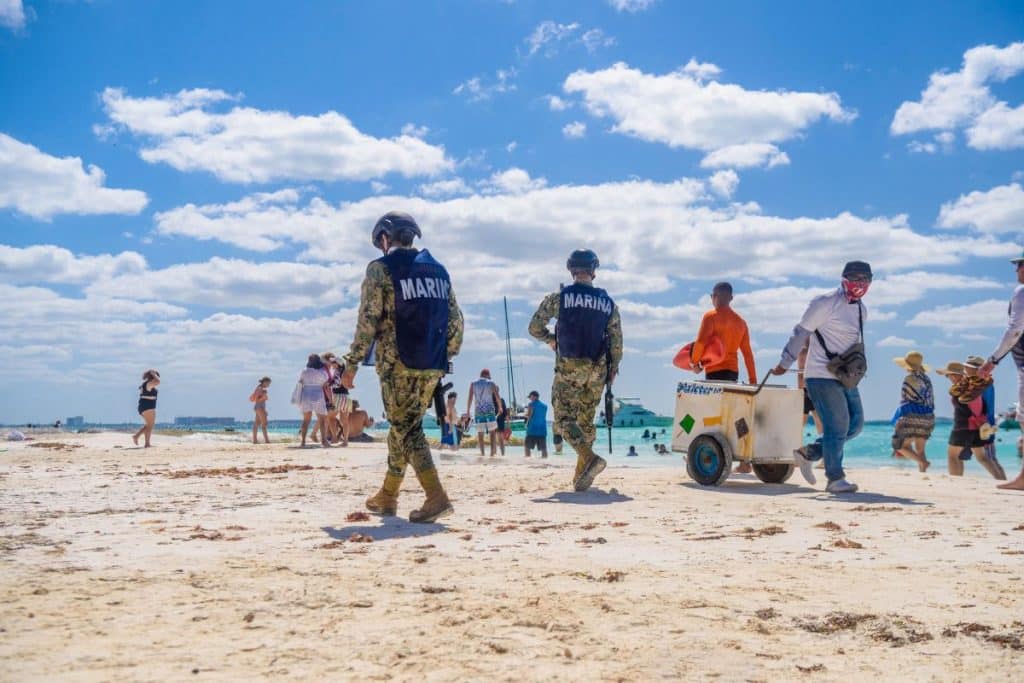Mexico is considered a safe country to visit, but there are numerous dangerous areas and regions that tourists should avoid traveling to. Travelers should also follow general safety measures (listed below) daily while visiting Mexico.
Which areas in Mexico are currently dangerous for tourists?
The US Department recently warned citizens against traveling to Baja California, Tijuana, Colima, Guerrero, Michoacan, Sinaloa and Tamaulipas, as a result of increasing criminal activities. Americans and other foreign visitors, as well as local hospitality workers, have been killed in several attacks in recent months.
Mexico travel warning map
Recent safety updates and news from Mexico:
November 16 – Very Safe Region near Cancun named top destination in 2024 according to new report
Merida is recognized as the safest city in Latin Mexico, and Yucatan is known as the safest state. This reputation for safety ensures that tourists can visit with a sense of tranquility, undisturbed by the minimal crime rates reported in these areas. The upcoming launch of the remarkable Mayan Train next month is expected to increase the popularity of such enchanting cities. Improved connectivity through the train will attract more tourists and in turn benefit local businesses like never before.
August 31 – The United States updates its travel advisory for Mexico and removes the warning for Quintana Roo
The U.S. State Department on Tuesday changed its travel advisory for Mexico and withdrew its advisory on the crime of kidnapping in Quintana Roo. It also placed the state’s travel advisory at level 2 due to crime.
Due to recent crime and kidnappings, U.S. authorities strongly discourage travel to Colima, Guerrero, Michoacán, Sinaloa, Tamaulipas and Zacatecas.
For the same reason, travel to the states of Baja California, Chihuahua, Durango, Guanajuato, Jalisco, Morelos and Sonora was also discouraged.
Visitors were also urged to exercise extra caution when visiting Aguascalientes, Baja California Sur, Chiapas, Coahuila, Hidalgo, Mexico City, Mexico State, Nayarit, Nuevo León, Oaxaca, Puebla, Querétaro, San Luis Potosi, Tabasco, Tlaxcala and Veracruz .
Last but not least, in the states of Campeche and Yucatán you can only take the normal precautions.
Important safety precautions to observe Mind
- Inform your traveling companions and family at home about your travel plans. If you become separated from your tour group, send your GPS location to a friend. Take a photo of the taxi number and/or license plate and text it to a friend if you are taking a taxi alone.
- Use toll roads if possible and avoid driving alone or at night. Outside the capital or major cities, police and emergency services presence is extremely limited in many states.
- Be extra careful when visiting local taverns, nightclubs and casinos.
- Don’t show signs of wealth, such as wearing expensive watches or jewelry.
- Be especially careful when visiting banks or ATMs.
- Sign up for the Smart Traveler Enrollment Program (STEP) to receive alerts and help emergency responders find you.
- Follow the US Department of State on Facebook and Twitter.
- Follow the US Embassy on Facebook and Twitter,
- Read the Mexican safety report.
- Make an emergency plan. View the travel checklist.

Most common tourist traps/scams in Mexico to look out for
Some of the most common scams in Mexico to look out for are:
Fake ATMs – Normally, you might not think about the specific ATM you use when you withdraw money. But because there are so many fake ATMs in Mexico that steal your card details, you should keep this in mind.
Using reputable ATMs at recognized banks is the best way to avoid these scams. It is very likely that an ATM on the street that looks suspicious is one.
Restaurant scams – Restaurant scams are another problem that visitors to Mexico regularly encounter. This is a fairly simple trick where eateries give out the wrong change or overcharge customers. You can avoid falling into a restaurant scam if you just keep an eye on your bill.
Bird droppings scam – The bird poop scam is a variation on all the other “sticky junk.” robbery Basically, you get covered in disgusting things like bird droppings and a helpful passerby helps you wash it away. However, in reality, this person is robbing you of everything he can get from your pockets.
Move away from the person helping you immediately if you suspect this is happening.
Airport taxi surcharge – At airports there are always many people who want to take advantage of travelers. In Mexico, the airport taxi surcharge is a common method.
In this scam, the driver charges a high price for airport transportation by pushing you into a large van or not using the taximeter. This happens often, especially in Mexico City. To avoid this, always use authorized taxis in Mexico.
Quintana Roo Safety App
The Quintana Roo Tourist Office has the Guest assistant app download for free.
The app provides safety information, legal advice, a complaints hotline and coronavirus information, as well as access to a 24/7 bilingual call center for visitor assistance.
The app contains links and services for emergencies, extortion and kidnapping, theft, lost or stolen passports, roadside assistance and even a way to file complaints with local tourism service providers.
“An ongoing safety and protection strategy has been put in place, and … continues communication with State Police, along with federal and local agencies and the private sector, to maintain updated safety measures to provide a safe and enjoyable environment for residents and visitors retain.” said the director of the State Tourism Council.
The U.S. Department of State is modifying national alerts for specific states
While the State Department normally issues a level 1 through 4 warning for every country in the world, based on concerns about overall safety for travelers, the travel advisory for Mexico changed to specific states on May 2.
The change to Mexico’s warnings comes as the State Department moves away from concerns about Covid-19, which is also the focus of the US Centers for Disease Control and Prevention (CDC) warnings.
“The State Department’s goal is for U.S. citizens planning a trip to Mexico to focus on the specific area of Mexico to which they will travel,” they said.
FAQ
Not at this time. Travel to Tijuana and Rosarito, Baja California, poses a “serious risk,” according to U.S. officials. Following the arrest of a key cartel boss, the US Embassy in Mexico has advised American tourists to avoid Tijana, Rosarito and Baja California due to serious security concerns.
Ensenada is generally a quiet and safe city. The risk of crime is low and travelers can feel safe here. Citizens have great confidence in the police.
Cancun is considered relatively safe to travel, but due to several recent shootings between local gangs in the area, there have been warnings about traveling to the area.





